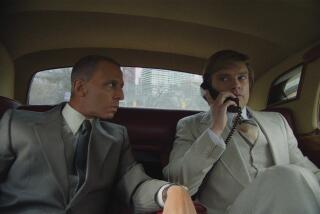A Walk in the Dark
- Share via
It took paranoid visionary Philip K. Dick to do what Stanley Kubrick could not: Get Steven Spielberg to fully cross over to the dark side. The question now is, how happy are we to have him there?
Spielberg’s “Minority Report” is amplified from a Dick short story by writers Scott Frank and Jon Cohen, and it stars Tom Cruise as a man hunted by the futuristic anti-crime unit he once led. It finds Hollywood’s preeminent director more convincingly at home with unapologetically bleak and unsettling material than he was with Kubrick’s “A.I.” “I wanted to make the ugliest, dirtiest movie I have ever made,” Spielberg told cinematographer Janusz Kaminski, and there’s little doubt he’s succeeded.
In a macro sense, this is a good thing. “Minority Report” is full of the pleasure this most proficient director feels in stretching himself, in redeploying his formidable skills and avoiding, as many directors have not, simply making the same film over and over.
But the road to self-knowledge can be an uneven one, and as impressive as this disturbing, even haunting film can be, it does not feel all of a piece. If anything, “Minority Report” is trying to do too much, trying to combine elements--philosophical, futuristic, hard-boiled criminal--that haven’t been made to completely cohere. This is a film that gives us a lot to chew on, but not all of it has been properly digested.
What is best, and creepiest, about “Minority Report” comes from Dick, brilliant at envisioning a future that’s got us by the throat. Dick is essential here even though (a) his original was not a novel but a 31-page short story published in 1956 in a magazine called Fantastic Universe and (b) what was retained is little more than a core plot line (a system hunting one of its own) and single speculative premise. But what a premise that was.
Dick, whose fiction has been most prominently turned into “Total Recall” and the landmark “Blade Runner,” came up with the notion of a system that harnessed the minds of a trio of psychics who visualized murders before they happened to a police force that arrested perpetrators before any crime was committed. With his gift for wordplay (“replicant,” the key “Blade Runner” word, was his), Dick called the psychics “precogs” (from “precognition”) and the system itself Precrime.
As greatly fleshed out by Frank and Cohen, the two-hour, 17-minute “Minority Report” starts out with what is in effect a prologue that shows how the Precrime system, run by Chief John Anderton (Cruise) with a zeal that turns out to have distinctly personal underpinnings, actually works in Washington, D.C., in the year 2054.
When the precogs have their visions (filmed by effects house Imaginary Forces, which did the memorable opening titles for “Seven”), they are transferred to computerized images that the chief physically orchestrates to look for clues as to geographic location so he knows where to send his men. With crimes of passion, such as the one that opens the film, the race to get to the scene before the deed is done can be nerve-racking.
Precrime has turned Washington, the only city that uses it, into America’s safest: There hasn’t been a murder in the nation’s capital in six years. But now, on the eve of the system’s greatest triumph, a referendum on whether Precrime should go national, there are worries that the government wants to take it away from Anderton and Precrime’s founder, Lamar Burgess (Max von Sydow). In fact, slimy Justice Department operative Danny Witwer (Colin Farrell) seems to have just such a scenario in mind.
In Dick’s story, the precogs, “gibbering, fumbling creatures, with their enlarged heads and wasted bodies,” were considerably stranger than they are on film, where the comatose Art, Dash and Agatha lie suspended in a liquid solution in a secure room called the Temple. “It’s better,” someone says, “if you don’t think of them as human.”
It’s Agatha, a precog acting in a distinctly human way, that puts “Minority Report’s” plot into gear by grabbing Anderton, urgently whispering, “Can you see?” and directing his attention to a precog vision of a considerably older crime. Intrigued despite a warning that “you dig up the past, all you get is dirty,” Anderton starts to investigate. Which is also when Precrime suddenly fingers him as a murderer, claiming--and the system has never been wrong--that he will kill a man he’s never met or even heard of in exactly 36 hours.
Anderton on the run, staying ahead of his pursuers while trying to figure out if the method he’s devoted himself to could be flawed, takes up the bulk of “Minority Report.” Like several of the film’s aspects, the thriller plot is involving but only up to a point.
Working once again with cinematographer Kaminski and using a special process to create flat, washed-out colors, Spielberg has clearly enjoyed filming some of the creepier aspects of Anderton’s flight, like a meeting with rogue surgeon Dr. Solomon Eddie (Peter Stormare) to get an identity change. But “Minority Report’s” plot finally suffers from a pair of extremes. Initially, it has a tendency to be too intricate and difficult to follow. The film’s closing segment has the opposite feeling, going for the kind of conventional tidying up that overcompensates for whatever confusion it caused earlier.
The same dynamic is true with “Minority Report’s” profusion of futuristic gizmos, to a certain extent dreamed up by a team of deep thinkers (“usually you see these guys on ‘Nightline’ talking to Ted Koppel,” Spielberg told Wired Magazine) the director installed in a Santa Monica hotel.
Some of these ideas, like personalized advertising that calls out your name as you walk by, or identification by retina scan (hence those creepy eyeball-scanning mechanical spiders seen in the coming attractions) are intriguing. But often these futuristic devices clutter things up, and some of the film’s most elaborate stunts, some involving jet-powered police squads, feel over-produced in a way that detracts from “Minority Report’s” best segments.
Those would be Anderton’s investigation of and involvement with the precog world, which allows the film to speculate about such issues as whether knowing the future allows you to change it. “Minority Report” holds our attention most in its quietest moments, when Anderton visits key precog researcher Iris Hineman (Lois Smith) or, most grippingly, when he spends quality time with precog Agatha, a role that gives actress Samantha Morton (Oscar-nominated for Woody Allen’s “Sweet and Lowdown”) a chance to give a harrowing performance that touches a raw emotional nerve.
If Morton has the film’s most memorable performance, a word must be said for Cruise. Though his is the starring role, it is in some ways a thankless one, needing him to be the tireless turbine that powers this expensive cinematic machine and nothing more. It’s not the kind of work that wins awards, but without Cruise’s intensity almost willing our interest in Spielberg’s unrelentingly dark world, “Minority Report” wouldn’t have nearly as much life as it does.
MPAA rating: PG-13, for violence, brief language, some sexuality and drug content. Times guidelines: The violence is brief but fairly gruesome; an overall dark, creepy mood would be frightening to younger children.
‘Minority Report’
Tom Cruise...Chief Paul Anderton
Colin Farrell...Danny Witwer
Max von Sydow...Director Lamar Burgess
Samantha Morton...Agatha
Lois Smith...Dr. Iris Hineman
Tim Blake Nelson...Gideon
Steve Harris...Jad
Kathryn Morris...Lara Clarke
Twentieth Century Fox and DreamWorks Pictures present a Cruise/Wagner, BlueTulip, Ronald Shusett, Gary Goldman production, released by Twentieth Century Fox. Director Steven Spielberg. Producers Gerald R. Molen, Bonnie Curtis, Walter F. Parkes, Jan De Bont. Executive producers Gary Goldman, Ronald Shusett. Screenplay Scott Frank and Jon Cohen, based upon a short story by Philip K. Dick. Cinematographer Janusz Kaminski. Editor Michael Kahn. Costume designer Deborah L. Scott. Music John Williams. Production designer Alex McDowell. Art directors Leslie McDonald, Ramsey Avery, Seth Reed. Set decorator Anne Kuljian. Running time: 2 hour, 17 minutes.
In general release.
More to Read
Only good movies
Get the Indie Focus newsletter, Mark Olsen's weekly guide to the world of cinema.
You may occasionally receive promotional content from the Los Angeles Times.











